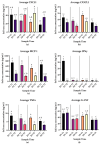A Prospective Cohort Study on the Effects of Repeated Acute Stress on Cortisol Awakening Response and Immune Function in Military Medical Students
- PMID: 39595087
- PMCID: PMC11592205
- DOI: 10.3390/biomedicines12112519
A Prospective Cohort Study on the Effects of Repeated Acute Stress on Cortisol Awakening Response and Immune Function in Military Medical Students
Abstract
Background: The cortisol awakening response (CAR) is a pivotal component of the body's stress response, yet its dynamics under repeated acute stress and its interplay with immune biomarkers remain inadequately understood. Methods: This study examined 80 second-year military medical students undergoing a 5-day intensive surgical simulation designed to elicit stress responses. Salivary samples were collected daily upon waking and 30 min thereafter to measure cortisol and a panel of cytokines using bead-based multiplex ELISA. Results: Analysis revealed a significant blunting of the CAR on the third day of training (p = 0.00006), followed by a recovery on the fourth day (p = 0.0005). Concurrently, specific cytokines such as CXCL1 (r = 0.2, p = 0.0005), IL-6 (r = 0.13, p = 0.02), IL-10 (r = 0.14, p = 0.02), and VEGF-A (r = 0.17, p = 0.003) displayed patterns correlating with the CAR, with increased strength of associations observed when assessing cytokine levels against the CAR of the preceding day (CXCL1 r = 0.41, p = 0.0002. IL-6 r = 0.38, p = 0.0006. IL-10 r = 0.3, p = 0.008. VEGF-A r = 0.41, p = 0.0002). Conclusions: These results suggest a temporal relationship between stress-induced cortisol dynamics and immune regulation. The CAR pattern demonstrated in this study may represent induction of and recovery from psychological burnout. Moreover, the observed cytokine associations provide insight into the mechanisms by which stress can influence immune function. The results may have broader implications for managing stress in high-performance environments, such as military and medical professions, and for identifying individuals at risk of stress-related immune suppression.
Keywords: cortisol awakening response (CAR); hyper-realistic surgical simulation; immune function; repeated acute stress; salivary cytokines; stress physiology.
Conflict of interest statement
The authors declare no conflicts of interest. The funders had no role in the design of the study; in the collection, analyses, or interpretation of data; in the writing of the manuscript; or in the decision to publish the results.
Figures





References
-
- Contreras C.M., Gutierrez-Garcia A.G. Cortisol Awakening Response: An Ancient Adaptive Feature. J. Psychiatry Psychiatr. Disord. 2018;2:29–40. doi: 10.26502/jppd.2572-519X0038. - DOI
-
- Ivkovic N., Racic M. Biomarkers of Stress in Saliva/Biomarkeri Stresa u Pljuvački. Acta Fac. Medicae Naissensis. 2015;32:91–99. doi: 10.1515/afmnai-2015-0010. - DOI
Grants and funding
LinkOut - more resources
Full Text Sources
Medical

